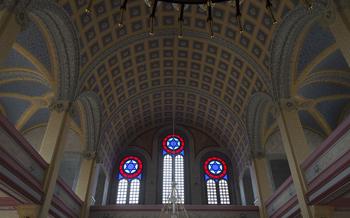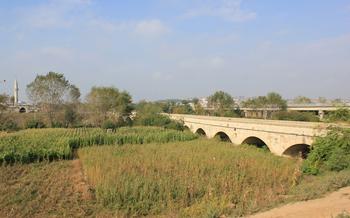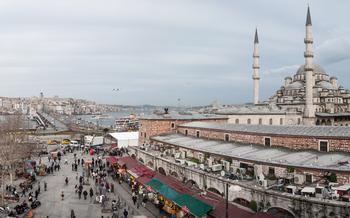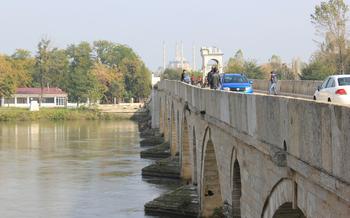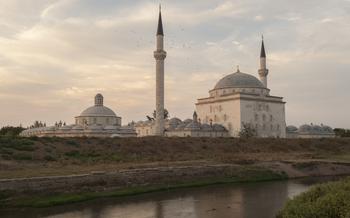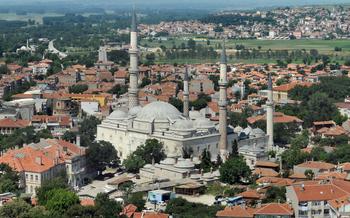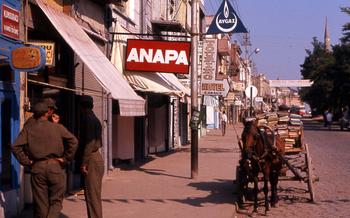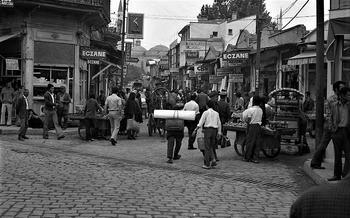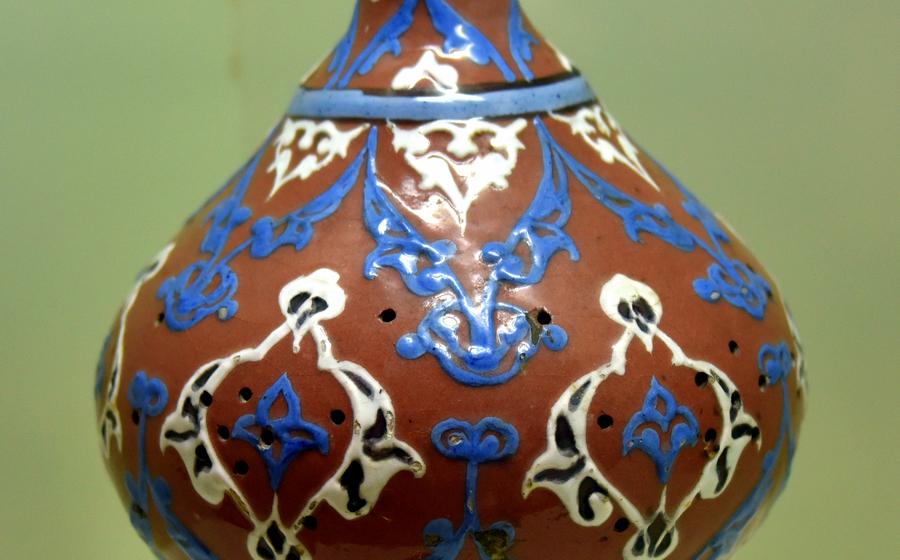
The Museum of Turkish and Islamic Art
- History of the Museum
- Location and Accessibility
- Collections and Exhibits
- Interactive Displays
- Temporary Exhibitions
- Educational Programs
- Gift Shop and Bookstore
- Café or Restaurant
- Accessibility for Visitors with Disabilities
- Photography and Videography
- Hours of Operation and Admission Fees
- Dress Code and Etiquette
- Nearby Attractions and Activities
- Practical Tip:
- Seasonal Events and Festivals
- Insider Tip: Unveiling the Secret Garden
History of the Museum
The Museum of Turkish and Islamic Art in Edirne, Turkey, stands as a testament to the rich cultural heritage of the region. Established in 1924, the museum occupies the former Great Synagogue of Edirne, an architectural marvel that dates back to the 15th century. During the Ottoman era, Edirne served as the second capital of the empire, and the synagogue symbolized the thriving Jewish community that resided there.
The museum's collection boasts a diverse array of artifacts that chronicle the artistic and cultural achievements of the Turkish and Islamic civilizations. From intricately woven carpets to illuminated manuscripts and exquisite ceramics, each piece narrates a chapter in the region's storied history. The architectural design of the museum itself is a blend of Ottoman and Moorish influences, featuring intricate stone carvings and vibrant tilework that transport visitors to a bygone era.
One fascinating anecdote surrounding the museum's restoration process recounts the discovery of a hidden treasure. During renovations, workers stumbled upon a secret chamber beneath the synagogue's floor, revealing a trove of ancient coins, jewelry, and religious texts that had been concealed for centuries. This remarkable find not only enriched the museum's collection but also shed new light on the history of Edirne's Jewish community.
Location and Accessibility
The Museum of Turkish and Islamic Art is conveniently situated in the heart of Edirne, a city steeped in history and cultural heritage. Located at [insert exact address], the museum is easily accessible on foot or by public transportation. If you prefer to drive, ample parking is available nearby, making it convenient for visitors arriving by car.
To reach the museum, you can take a leisurely stroll from the city center, admiring the charming streets and historical landmarks along the way. Alternatively, several bus lines stop within a short walk of the museum, making it easily accessible from different parts of Edirne.
For a hassle-free visit, plan your trip outside of peak tourist season to avoid crowds. The museum is generally less crowded during weekdays and early mornings, allowing you to fully immerse yourself in the exhibits without feeling rushed.
Collections and Exhibits
The Museum of Turkish and Islamic Art in Edirne boasts a diverse collection that spans centuries of Turkish and Islamic history. Immerse yourself in the rich cultural heritage as you explore galleries dedicated to various periods and regions. Marvel at the intricate designs of hand-woven carpets, each telling a unique story through its patterns and colors. Discover rare manuscripts, illuminated with exquisite calligraphy and vibrant illustrations, inviting you to delve into the world of Islamic scholarship. Admire the delicate ceramics, adorned with intricate motifs and glazes, showcasing the mastery of Turkish artisans. From monumental tiles to delicate glasswork, every artifact in this museum is a testament to the artistry and craftsmanship that have shaped Turkish and Islamic culture.
Anecdote:
During my visit, I stumbled upon a hidden gem tucked away in a corner of the museum. It was a small, unassuming display of traditional Turkish shadow puppets. Intrigued, I spent the next hour captivated by the intricate details of these delicate figures and the stories they represented. The puppet master, who happened to be present, shared insights into the art of shadow puppetry and its significance in Turkish culture. It was a serendipitous encounter that enriched my understanding of the museum's collection and left me with a lasting memory.
Interactive Displays
The Museum of Turkish and Islamic Art keeps pace with modern technology to enhance the visitor experience. Interactive displays, touchscreens, audio guides, and virtual reality elements are strategically placed throughout the galleries. Visitors can immerse themselves in the history and significance of the collection through interactive maps, 3D models, and multimedia presentations. These interactive features bring the artifacts to life and engage visitors of all ages.
Practical Tip:
Reservations for guided tours or workshops are highly recommended to make the most of the interactive exhibits. Check the museum's website or contact them in advance to book your spot.
Temporary Exhibitions
The Museum of Turkish and Islamic Art keeps its collection fresh and dynamic by hosting temporary exhibitions alongside its permanent displays. These special exhibits showcase rare artifacts, unique collections, and themed presentations that complement the museum's core offerings. Visitors can expect to see rotating exhibitions that delve into specific periods, regions, or artistic styles.
Currently, the museum is hosting an exceptional exhibition titled "The Art of Illumination: Manuscripts from the Islamic World." This exhibit showcases a stunning collection of illuminated manuscripts from various parts of the Islamic world, dating back to the 8th century. Visitors can marvel at the intricate calligraphy, vibrant colors, and elaborate illustrations that adorn these historical documents.
Temporary exhibitions at the Museum of Turkish and Islamic Art offer a unique opportunity to see rare and exceptional artifacts that may not be on permanent display. These exhibits provide a deeper insight into the diverse artistic traditions and cultural heritage of Turkey and the Islamic world.
Anecdote:
During my last visit to the museum, I had the pleasure of attending a temporary exhibition on the history of Turkish carpets. I was fascinated by the intricate designs, vibrant colors, and symbolic motifs that adorned these beautiful carpets. The exhibition provided an in-depth look at the techniques and traditions of Turkish carpet weaving, and I gained a newfound appreciation for this ancient craft.
Educational Programs
The Museum of Turkish and Islamic Art offers a variety of educational programs, workshops, and lectures to engage visitors of all ages. These programs are designed to deepen understanding and appreciation of Turkish and Islamic art and culture.
For children, the museum offers hands-on workshops and interactive activities that introduce them to the basics of Islamic art and design. They can learn about calligraphy, tile-making, and miniature painting, creating their own artworks inspired by the museum's collection.
Adults can participate in lectures and seminars by renowned scholars and experts, delving into the history, techniques, and symbolism of Islamic art. These programs provide a deeper understanding of the cultural and religious significance of the artifacts on display.
To stay updated on upcoming events and programs, visitors can check the museum's website or contact the education department directly. Reservations for guided tours or workshops may be required, so booking in advance is recommended.
Practical Tip: Check the museum's website or contact them directly to inquire about upcoming events and programs. Reservations may be required for guided tours or workshops, so booking in advance is recommended.
Gift Shop and Bookstore
The Museum of Turkish and Islamic Art houses a well-stocked gift shop and bookstore, allowing visitors to take a piece of the museum experience home with them. The shop offers a diverse selection of souvenirs, books, and merchandise related to the museum's collection. From intricate replicas of historical artifacts to colorful textiles and ceramics, there is something for every taste and budget.
The bookstore is a treasure trove for those interested in Turkish and Islamic art and culture. Here, visitors can find a wide range of books, catalogs, and publications covering various aspects of the museum's collection, including its history, exhibits, and restoration projects. Whether you're an art enthusiast, a history buff, or simply looking for a unique gift, the museum's gift shop and bookstore are worth exploring.
Practical Tip: Remember to check if the shop accepts multiple payment methods, including credit cards and local currency. Some museums may also offer online shopping for those who prefer to purchase souvenirs from the comfort of their homes.
Café or Restaurant
Within the confines of the museum complex, visitors can find solace and sustenance at the charming café or restaurant. These culinary havens offer a delightful respite from the immersive journey through history and culture. Indulge in a delectable array of traditional Turkish cuisine, savoring the rich flavors and aromas that have tantalized taste buds for generations.
The café beckons with its inviting ambiance, inviting visitors to linger over aromatic Turkish coffee or invigorating tea. As you sip your beverage of choice, let the museum's ambiance wash over you, allowing the stories and artifacts you've encountered to settle within your consciousness.
For a more substantial repast, the restaurant awaits with a tantalizing menu featuring both traditional Turkish fare and international favorites. Savor the succulent kebabs, fragrant pilafs, and delectable pastries, all prepared with fresh, local ingredients and infused with the culinary passion that defines Turkish cuisine.
As you dine, the museum's collection provides a captivating backdrop, enhancing the experience with a sense of history and cultural immersion. Whether you choose to unwind with a light snack or indulge in a leisurely meal, the café and restaurant at the Museum of Turkish and Islamic Art offer a culinary adventure that complements and enriches the exploration of this treasured institution.
Accessibility for Visitors with Disabilities
The Museum of Turkish and Islamic Art in Edirne is committed to providing an inclusive and accessible experience for all visitors. The museum is wheelchair accessible, with ramps and elevators available throughout the building. Visitors with disabilities can also request assistance from the museum staff, who are trained to provide support and guidance. Additionally, the museum offers special facilities and services for visitors with disabilities, such as audio guides and tactile exhibits. Visitors with disabilities are entitled to a 50% discount on admission fees. The museum also offers free admission for one companion accompanying a visitor with a disability.
Practical Tip: Before your visit, contact the museum in advance to inquire about any specific accommodations or services you may require. This will ensure that you have a smooth and enjoyable experience at the Museum of Turkish and Islamic Art.
Photography and Videography
Photography and videography policies vary depending on the museum's regulations and the type of exhibit. Generally, photography is allowed for personal use, but flash photography and tripods may be restricted in certain areas to protect the artifacts. Be sure to follow the signs and guidelines posted throughout the museum.
It is important to be respectful of the museum and other visitors when taking photos or videos. Avoid blocking exhibits or disturbing others while capturing your memories. If you have any questions or concerns, feel free to ask a museum staff member for assistance.
Practical Tip:
- Consider bringing a small, compact camera or smartphone instead of a bulky DSLR or tripod to avoid attracting attention or causing inconvenience.
Hours of Operation and Admission Fees
The Museum of Turkish and Islamic Art in Edirne welcomes visitors throughout the week with specific hours of operation. Its doors are open from Tuesday to Sunday, between the hours of 9:00 AM and 5:00 PM. It remains closed on Mondays, allowing for maintenance and preparation for the upcoming week.
Admission to the museum is subject to a modest fee, ensuring the preservation and upkeep of the valuable artifacts within. Regular admission costs 20 Turkish Lira (TL) for adults, while students and senior citizens can enjoy a discounted rate of 10 TL. Additionally, the museum offers free admission to children under the age of 12, encouraging families to immerse themselves in the fascinating world of Turkish and Islamic art.
Consider purchasing your tickets online or in advance to avoid queues, especially during peak tourist seasons. This will allow you to breeze through the entrance and make the most of your time exploring the museum's treasures.
Dress Code and Etiquette
When visiting the Museum of Turkish and Islamic Art, it is important to dress respectfully, as it is a place of cultural and historical significance. While there is no strict dress code, modest attire is recommended. Visitors should avoid wearing shorts, tank tops, or revealing clothing. It is also important to be mindful of noise levels and refrain from talking loudly or disturbing other visitors.
Anecdote: During my visit to the museum, I witnessed a heartwarming gesture that exemplified the importance of cultural sensitivity. A group of foreign tourists entered the museum wearing shorts and tank tops, which were not considered appropriate attire. Instead of reprimanding them, a museum volunteer politely approached them and offered them shawls to cover their shoulders. The tourists were grateful for the gesture and showed their appreciation by following the museum's dress code. This incident highlighted the museum's commitment to promoting cultural understanding and respect among visitors.
Nearby Attractions and Activities
The Museum of Turkish and Islamic Art is situated in the heart of Edirne, a historic city brimming with cultural attractions and activities. Within walking distance of the museum, visitors can explore the grandeur of the Selimiye Mosque, a masterpiece of Ottoman architecture renowned for its soaring minarets and breathtaking interior. The Edirne Palace, once the residence of Ottoman sultans, offers a glimpse into the opulent lifestyle of the past.
For a taste of local flavors, wander through the vibrant Edirne Bazaar, where vendors display an array of traditional Turkish delights, handicrafts, and souvenirs. History buffs can delve deeper into the city's past at the Edirne Archeological and Ethnography Museum, showcasing artifacts from various civilizations that have shaped the region.
Nature enthusiasts can find respite in the tranquil Edirne Dam Lake, a scenic spot ideal for leisurely strolls or birdwatching. The Karaağaç Park, with its lush greenery and serene atmosphere, provides a welcome escape from the city's hustle and bustle.
Practical Tip:
To make the most of your visit, consider creating a walking tour or itinerary that allows you to explore the museum and its surrounding attractions. This will enable you to fully immerse yourself in the rich history and culture of Edirne.
Seasonal Events and Festivals
Edirne's cultural heritage comes alive during the many festivals and events held throughout the year. The traditional Kırkpınar Oil Wrestling Festival is a highlight, attracting thousands of spectators to witness the ancient sport of oil wrestling. Held annually in July, this festival showcases the strength and agility of wrestlers competing in a centuries-old tradition.
The Hıdırellez Festival is another vibrant celebration observed in May, marking the arrival of spring with picnics, music, and dancing. The Museum of Turkish and Islamic Arts often participates in these events, hosting special exhibitions, workshops, and performances that immerse visitors in Turkey's rich cultural traditions.
I once had the privilege of attending a Hıdırellez celebration at the museum, where I witnessed traditional Turkish folk dances, listened to enchanting music, and savored delicious local cuisine. The atmosphere was electric as people from all walks of life came together to celebrate the beauty of Turkish culture.
Insider Tip: Unveiling the Secret Garden
Beyond the grand halls and intricate exhibits, the Museum of Turkish and Islamic Art holds a hidden gem that often goes unnoticed by visitors. Tucked away in a secluded corner of the museum complex lies a serene and enchanting secret garden. This oasis of tranquility invites visitors to escape the hustle and bustle of the city and immerse themselves in the beauty of nature.
As you step into the garden, you are greeted by a symphony of colors and fragrances. Lush green foliage, vibrant flowers, and aromatic herbs create a captivating display that delights the senses. Follow the winding paths that lead you through this hidden paradise, discovering hidden nooks and charming seating areas along the way.
Take a moment to sit beneath the shade of a towering cypress tree and let the gentle breeze carry away your worries. Listen to the soothing sounds of birdsong and the rustling of leaves as you contemplate the beauty of the surroundings. The secret garden is the perfect place to find respite from the busy museum halls and to reconnect with your inner peace.
Insider tip: The secret garden is most magical during the spring and summer months when the flowers are in full bloom. Be sure to visit early in the morning or late in the afternoon to avoid the crowds and fully appreciate the tranquility of this hidden gem.

